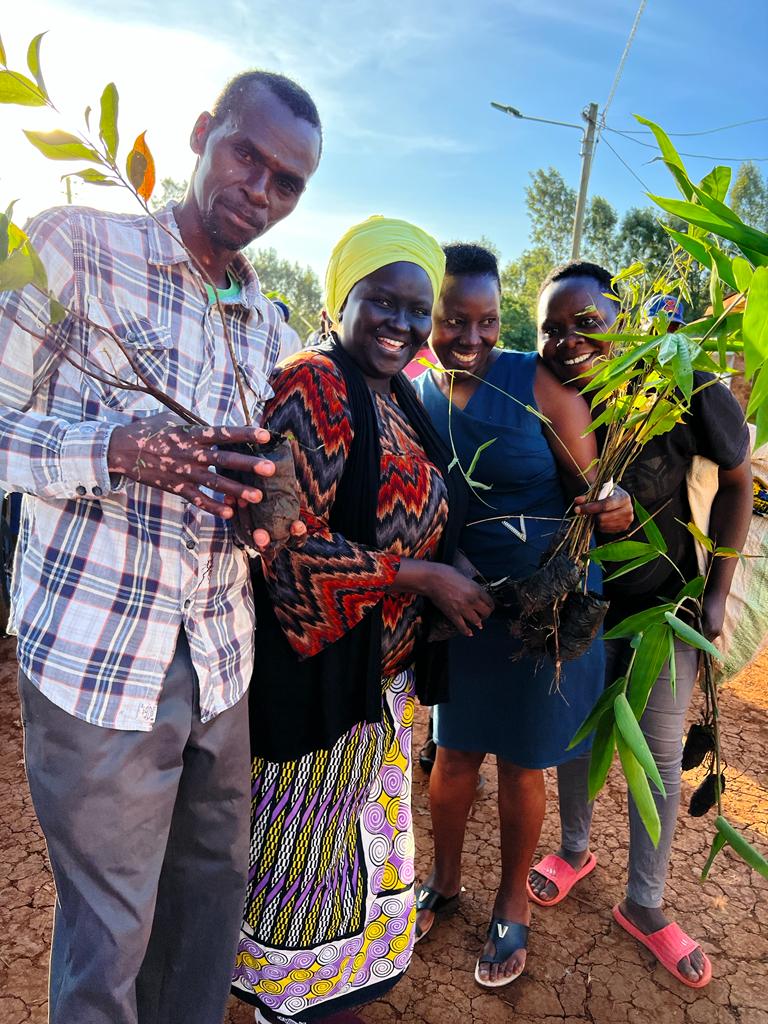Groundbreaking Workshop on AI and Technology-Facilitated Gender-Based Violence at AWiM24
Trending
Saturday May 31, 2025
Trending


Beth Waithira (2nd left with a head turban) who has embarked on planting bamboo along drying rivers. Photo/ Milliam MurigiNairobi
Growing up, Beth Waithira Mburu Kibinda, 41, used to watch her grandmother get water from a natural spring a few metres away from their homestead. Unfortunately, because of people cutting down trees without replanting, the spring dried up.
Though her grandmother was lucky to put up a water tank to harvest rainwater, most of her neighbours couldn’t afford the same. That meant prolonged walking distances before finding the resources. Unfortunately, clean water was not readily available and in places where boreholes had been sunk, the water was excessively salty.
“I come from the semi-arid part of Murang’a called Ndonga, which is in Kahumbu Ward, Kigumo Constituency. Our greatest challenge has been accessing clean and safe water. All through I have wanted to solve this problem but I didn’t know how to do it,” she says.
Water scarcity is a big problem not only in this village but across the country. According to data available at Water.org, organisations focusing on water and sanitation globally, with a population of 53 million, 15 per cent of Kenyans rely on unimproved water sources, such as ponds, shallow wells and rivers, while 41 per cent of Kenyans lack access to basic sanitation solutions. These challenges are especially evident in rural areas and urban slums where people are often unable to connect to piped water infrastructure. This problem not only affects humans but also wildlife, agriculture and fishing.
According to Beth, one day, as she was going about her duty of community development, she met a man who introduced her to the giant bamboo trees and their benefits. After listening to him and learning that bamboo can be used to mitigate climate change, she started visualizing how her village could benefit from these trees.
Giant bamboo is just one species of bamboo grass that has been demonstrated to grow in Kenya.
There are more than 1,500 species of bamboo. Out of these, 16 species have been demonstrated to grow in Kenya. Apart from climate mitigation, bamboo has several uses and more products can be made out of it.
After that, she decided to introduce bamboo back to her village. She even joined hands with the community and on 8th January 2022, she launched Waithira Wa Kibinda Greening Murang’a Initiative an initiative that saw about 700 giant bamboo seedlings planted next to dried up or drying rivers and water sources.
They also planted a few hardwood trees in the shopping centres to offer some much-needed shade for the community.
“I started by planting these trees in our village because I understand the problem our neighbours are going through. Eventually, I want to plant these trees across the entire Murang’a County. My plan is to be planting about 10,000 bamboo trees every year close to dried up springs and wells. This will help to raise the water table and that means that people will easily access clean water.”
According to her, the good thing about this initiative is that it is not only helping to fight climate change thus bringing clean and safe water closer to the residents, but also it is an economic empowerment project which will contribute to the achievement of the Sustainable Development Goal (SDG) number six which is about clean water and sanitation for all as well as goal number one that calls for an end to poverty in all its manifestations by 2030 and goal number seven that aims to ensure access to affordable, reliable, sustainable and modern energy for all.
It also touches on goal number 13 urges on taking action to combat climate change and its impacts as well as goal number 15 which is about life on land. Bamboo addresses this goal because it is one of the greatest tools of land protection and restoration.
“Bamboo qualifies as a renewable resource because unlike other sources of biomass (trees), it matures in about four years and can be harvested for many years. If Kenyans will embrace it, they will not only benefit from clean water in the long run and sales of some of the bamboo products but also they will benefit from an affordable source of clean energy,” she says.
And why bamboo and not any other tree? Waithira says that giant bamboo trees have extensive fibrous roots that will control soil erosion thus making soils more stable for farming. Apart from that bamboo also raises the water table and she expects that within the next three to five years dried-up rivers will start to rise and curb the harsh water shortages experienced in most parts of Murang’a. Bamboo is also being promoted by the government as a uniquely Kenyan solution to climate change.
“Bamboo is also surprisingly effective carbon sink because it converts carbon dioxide to oxygen at a 30 per cent rate higher than normal trees thus purifying the air for residents. Once mature, the bamboo tree is highly marketable to coffee factories when drying coffee berries since bamboo combusts faster and that means indigenous trees will also be spared to grow for longer. In addition, bamboo timber is also used to make furniture.”
According to Victor Mwanga, Executive Director Tiriki Tropical Gardens & Farm Limited (TTGF) a Bamboo Value Chain Centre based in Kaimosi in Western Kenya, the secret to bamboo’s success is that it’s a grass and not a tree. It grows fast and accumulates carbon quickly. It also has an extensive root system that survives annual harvesting. This makes bamboo a fast-regenerating resource, which can supply more biomass than both natural and planted forests.
“The reason as to why Bamboo is gaining attention alongside tree-planting is because of its potential role in removing large amounts of carbon dioxide from the atmosphere, which will contribute to keeping global warming below 1.5C. Bamboo also can grow anywhere where grass grows, in all types of ecological zones including arid and semi-arid areas. What is important is the site to species matching,” said Mr Mwanga.
Bamboo is also a fast-growing tree. Actually, available research at TTGF shows that bamboo shoots can grow at an astounding speed and some bamboo species have been recorded to grow at a rate of 90cm per day, which means about 3.8cm per hour. This means that the growth time from one culm to another would be about one month which cannot be achieved by other trees.
According to Lawrence Aura, founder of a company that uses bamboo to make furniture and other artwork, climate benefits aside, bamboo is also an attractive plant for the private sector. Kenyan factories have even started to produce flooring, furniture, paper and various alternatives to plastic, for a growing international market.
Mr Aura believes that it is perhaps the growing appetite for bamboo products that will make it a bigger climate solution as a replacement for wood, and as an incentive to plant more on Kenya’s degraded lands.
And where is she getting funds to run this initiative? She reveals that apart from administrative costs that she is providing, the trees were a donation and she is looking forward to partnering with the Kenya Wildlife Service, the Kenya Forest Service, more communities, and other stakeholders to expand the initiative since the initiative is a project that is expected to outlast her and the team.
To ensure that all trees planted grow to maturity, she first started by selling her vision to community members concerning the benefits of planting the trees. She also had to empower them and help them understand that these resources belong to them; their lives literally depend on resources like these and so they must protect them. After that, those residents promised to nurture the trees and even those that were planted in the shopping centres have volunteers willing to sacrifice a few litres of water per week to ensure that the trees thrive.
“This initiative is my heartfelt contribution to the environment hence I will definitely keep planting trees in Murang’a and once the initiative can run on its own, move on to other counties. The late Nobel Laureate Wangari Maathai is my role model and just like her, in this new season of my life I plan to plant trees whenever I have something to celebrate,” she concluded.
This article is part of African Women in Media (AWiM)/UNEP Africa Environment Journalism Programme
Would you like to republish this story? Kindly contact janet@africanwomeninmedia.com
We’re not gonna spam. We’ll try at least.

Copyright 2020. African Women In Media
Copyright 2020. African Women In Media
Recent Comments